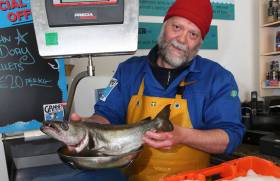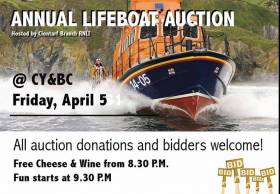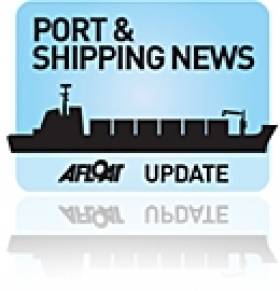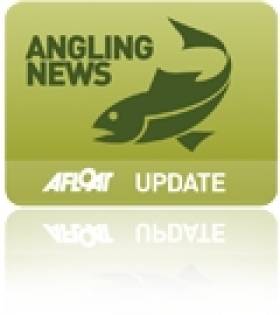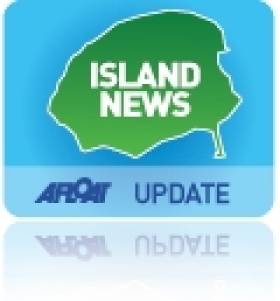Displaying items by tag: Auction
One Galway fishmonger stocking up ahead of the perennially busy Good Friday trade got more than he bargained for with his catch of the week.
Stefan Griesbach from Gannet Fishmongers and Eatmorefish.ie came across a fish a lot more unusual than the average cod and whiting in the 2kg meagre (Argyrosomus regius) — also known as the croaker fish — a relative of the stone bass which is a farmed fish popular on many Irish restaurant menus.
Common in the waters in south-west of France or west of Africa, the meagre, despite its name, is not so small by nature.
Indeed, the 2kg specimen Stefan spotted in Rossaveal on Monday (14 April) is just a fraction of its cousins that can reach up to two metres in length and weigh more than 200kg.
Meagre is a renowned game fish but also prized for its meaty fillets, which was the big attraction for Stefan when he found it in a mixed box of fish, having been caught by the MFV Killoran south of the Aran Islands on its first trip.
However, before taking the knife to this unique Easter treat, Stefan got in touch with Dr Declan Quigley of the Sea Fisheries Protection Authority to find out just how rare his purchase really was.
And he was surprised to learn that records show only two other meagre/croaker catches in Irish waters, at Passage West, Co Cork in 1840 and Annagassan, Co Louth in 1896 — both in the Victorian era of the 19th century.
Now the special catch is up for auction in aid of the RNLI. Bidding starts at €75 for the auction which closes midday on Thursday 18 April so be sure to act fast.
Friday night is sure to be a winner on Dublin Bay as Clontarf Yacht & Boat Club hosts its annual auction night in aid of the Howth RNLI lifeboat tonight, Friday 5 April.
Gary Sargent and Elaine Ball will host the auction from 9.30pm with many items up for bidding, including vouchers for Irish Ferries and Stena Line.
The CY&BC also invites attendees to bring along their own items for auction to raise finds for the lifesaving charity.
Complimentary wine and cheese will be served for those who come early from 8.30pm.
Titanic Auction Takes The Biscuit As Cracker Fetches €21,000
#Titanic - A Greek collector has paid £15,000 (€21,000) for a pilot cracker found in a lifeboat kit from the Titanic, as BBC News reports.
Aptly described as "the world's most valuable biscuit" by auctioneer Andrew Aldridge, the Spillers and Bakers cracker was one of a number of items relating to the Titanic tragedy that sold at auction in October.
Among them was a photo showing what's believed to be the iceberg that the liner struck on that fateful night on 14 April 1912, and a 'loving cup' presented to the captain of the Carpathia, which responded to the Titanic's distress calls, that went to a British-based collector for a whopping £129,000 (€181,000).
BBC News has more on the story HERE.
Drug Yacht Makaybella To Be Auctioned In Cork
#makaybella – A 62–ft custom cruising sailboat, the SY Makaybella, is to be auctioned in Cork at the end of this month. The sailing yacht was seized last September by the Irish Navy after it was intercepted in the Atlantic about 200 miles (322km) off the south west coast of Ireland.
As Afloat.ie reported last September, the sea raid followed a covert surveillance operation to track the 60ft yacht from Venezuela.
A haul of 41 bales of cocaine discovered onboard was initially valued at €80m but such was the purity of the drugs at 70pc it was re–estimated to have a street value of around €350m.
Intelligence sources said it was understood the drugs were heading for the north Wales coast.
The yacht is now for sale 'as seen as is' at Haulbowline in Cork Harbour under the direction of An Garda Siochana.
The 28–year–old yacht will be auctioned – unless previously sold – at 12 noon on Thursday, 30th July at the Carrigaline Court Hotel, Carrigaline, Co. Cork.
The auctioneer is Dominic J. Daly & Co Pembroke House Tel: 021 – 4277399 Email: [email protected]
More details on the yacht here
#folkboat – A 26ft–clinker Built 'Folkboat' discovered after ten years in storage will go under the hammer later this month. Auctioneer David Herman of Herman Wilkinson Auctioneers in Dublin says the ex–Galway classic boat named 'WAIRINGI' is a 'fabulous restoration project opportunity'.
The wooden clinker built boat is to be sold without reserve to the highest bidder at the auction. Viewing of the craft is: Sun 21st June 3pm – 5pm & Mon 22nd June (day of auction) 11am to the start of auction in Newcastle, Co. Wicklow
More information and photos on Afloat's boats for sale site HERE and from David Herman on 01 4972245
Admiralty Marshall Directs Sale of 'Clipper Faith' Cargo Vessel Berthed in Dublin Port
Clipper Faith, the cargo vessel at the centre of a High Court proceedings earlier this month is to go for public auction by direction of Admiralty Marshall one of the largest vessels directed to be sold this way in recent years.
The auction will be held at 12.00 noon on Friday, 14th June 2013 at the Clarion Hotel, IFSC Centre, North Wall, Dublin 1.
Earlier this month a High Court judge expressed concern for the crew of the Belize registered 19,000 tonnes cargo ship detained in Dublin Port since last March and who have not been paid since late last year.
Further details, photographs & conditions of sale from auctioneer Dominic Daly is below and downloadable MS word file below.
PUBLIC AUCTION
(if not previously sold)
BY DIRECTION ADMIRALTY MARSHALL
THE HIGH COURT
DUBLIN, IRELAND.
M.V. CLIPPER FAITH
IMO No 9149677. Registered Belize City.
Built 1998, China. Bulk Carrier.
L.O.A. 181.00m. B 26.00m. D 14.40m
GRT 19,354. NET 9,614.
Engines Man B&W, 5S50MC, MCR-6400KW, MSR-5760KW
Auction: 12.00 noon on Friday, 14th June 2013
At the Clarion Hotel, IFSC Centre, North Wall, Dublin 1, Ireland.
The vessel is offered For Sale AS SEEN AS IS at Dublin Port.
Further Details, Photographs & Conditions Of Sale from:
DOMINIC J. DALY, AUCTIONEER
PEMBROKE HOUSE, PEMBROKE STREET, CORK, IRELAND.
Tel: (353) 21 4277399 or mobile: (353) 87 2550486
Email: [email protected]
Full advert on the Commercial section of the Afloat Boats for Sale website
Titanic Artifacts a Snap - at $189 Million!
#TITANIC - The Titanic is for sale - if you have a spare $189 million to spend, according to the Los Angeles Times.
The single-lot auction, which will take place in April on the 100th anniversary of the Belfast-built ocean liner's tragic demise, includes more than 5,000 items salvaged from the wreck, from gold coins and clothing to parts of the ship's hull itself.
But casual buyers need not apply, as aside from the multi-million-dollar outlay, the prospective purchases must also take on stewardship over the collection, preserving it for future generations and exhibiting parts of it to the public.
Arlan Ettinger, president of Guernsey's Auctioneers & Brokers in New York, commented: "It's like getting a puppy. When you bring it home, you don't think of all the responsibilities and the time and investment that will be required... But it takes great care."
Images of the items up for auction are available HERE.
Atlantic Salmon Trust Launches 2012 Auction Online
#ANGLING - The Atlantic Salmon Trust's 2012 Fishing Country Sports Auction went live this week, with some 300 lots offered - including three prime Irish fishing spots on the Blackwater, Mourne and Drowes.
“The annual auction remains our single most significant fundraising event and its success is essential to helping us continue our work,” said AST chief executive Tony Andrews in The Irish Times.
Aside from top fishing opportunities in England, Scotland and Wales, spots in Russia are also featured, as well as deer stalking excursions and shooting days.
For art lovers, sporting prints and watercolours are included in the lots, as is a limited edition of the acclaimed Atlantic Salmon Magic, and Salmon Rivers, one of the best recent publications on the Atlantic salmon. They could be the perfect gift for someone's Valentine's Day.
Bids will close on 14 February for the online auction at www.atlanticsalmontrust.org/auction/.
Auction of Aran Islands Passenger Ferry Sisters
Aran Direct (which was the trading name for Bád Arann Teoranta) operated on routes between Rossaveal to Inis Mór, Inis Meáin and Inis Oírr. The company competed in an intensely competitive market with at least 10 other vessels combined from the fleets of Aran Doolin Ferries, Aran Island Ferries and the Doolin Ferry Company.
In September 2008, Aran Direct ceased operations and the vessels were laid-up at Rossaveal, where they remain, as seen (if not previously sold) prior to the public auction.
At the instructions of Liam Dowdall Esq., Receiver & Manager, Bád Arann Teoranta (in receivership), the vessels are to be sold in one or separate lots. The public auction is to be held at 12 noon on Thursday 24th February at the Harbour Hotel, The Docks, Galway.
An outline of the vessels details can be downloaded in PDF format by clicking HERE. For further details, photographs and conditions of sale contact Dominic J. Daly, Auctioneer, Cork Tel: (021) 4277399 or E-mail: [email protected] and logging on to www.dominicjdaly.com
For further technical details, you can contact Noel O'Regan of Promara Ltd on 087 3435666 or email [email protected]



























